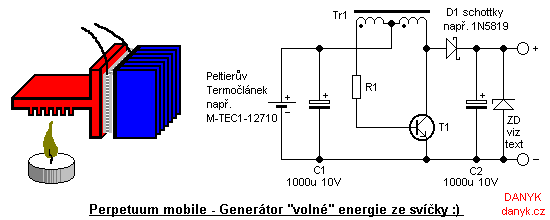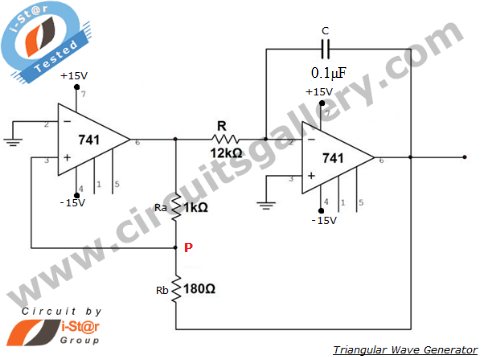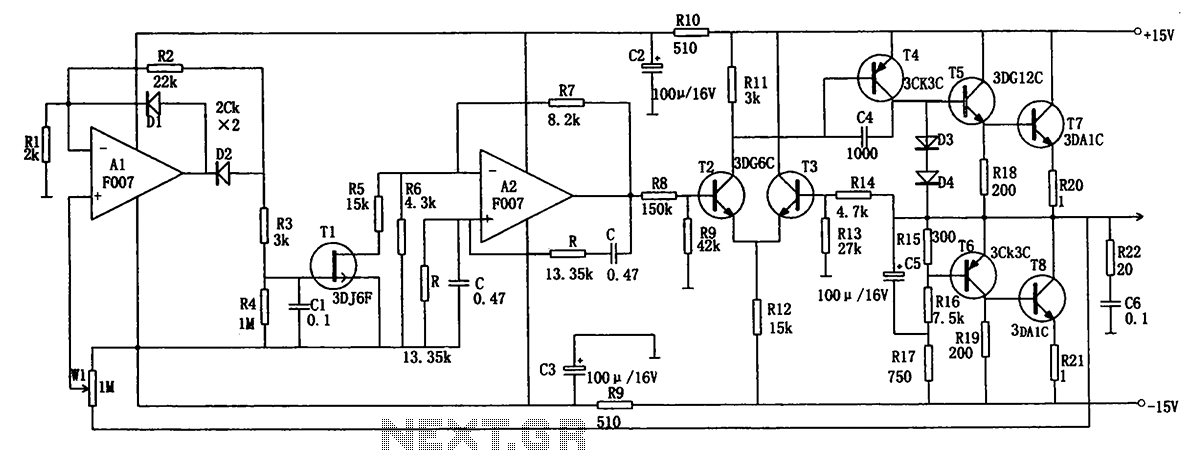
free energy generator from a candle

Introduction: This device is not a true perpetual motion machine or a source of free energy from the atmosphere; however, it presents an intriguing experiment, particularly for beginners and enthusiasts of alternative energy sources. It enables the generation of electricity from the heat produced by burning candles or other heat sources, such as burners, central heating systems, boilers, or radiators. The conversion of thermal energy into electricity is achieved using a Peltier cell (thermocouple), which is a reliable method that does not involve any moving parts, unlike traditional thermal power plants. Although the power output is modest, it is adequate for many small battery-operated devices. The principle behind this device is straightforward: when one side of the thermocouple is heated and the other side is cooled, the thermocouple generates an electrical voltage. Cooling is essential, as the second law of thermodynamics states that no machine can operate solely by being heated. Heating is accomplished using a candle, while cooling is achieved with a large passive heatsink from an old CPU. A cooling fan is not feasible, as its power consumption would likely surpass the generator's output. The greater the temperature difference, the higher the output voltage that the thermocouple can provide. An M-TEC1-12710 thermoelectric cooler (TEC) is utilized in this setup, but other types can also be employed. In this configuration, it operates in reverse mode. Two prototypes have been constructed; the first generates a stable voltage of approximately 0.8 V, while the second produces around 0.9 to 1 V, with a short-circuit current of nearly 0.5 A. The voltage output is insufficient for direct use with appliances but can be increased using an inverter. A Joule thief inverter with an LED was used for testing, as it can operate from a voltage as low as 0.4 V. For powering other devices, the circuit illustrated in the schematic diagram below can be utilized. The output is suitable for connecting a zener diode to stabilize the voltage at the desired level. The inverter can be employed to power devices requiring voltage in the range of 1.5 to 6 V.
The described device operates on the principles of thermoelectric generation, leveraging the Seebeck effect, which occurs in thermocouples. In this configuration, the thermoelectric cooler is repurposed to function in reverse, where a temperature gradient across its junctions induces an electromotive force (EMF). The use of a candle as a heat source is practical for small-scale applications, offering a simple yet effective means of generating thermal energy.
The choice of a large passive heatsink is critical for maintaining the necessary temperature differential between the hot and cold sides of the thermocouple. This heatsink should be made of a material with high thermal conductivity, such as aluminum or copper, to enhance heat dissipation. The efficiency of the thermoelectric generator can be improved by maximizing the temperature difference, thus optimizing the output voltage.
In terms of circuit design, the integration of a Joule thief inverter allows for the conversion of the low voltage generated by the thermocouple into a higher voltage suitable for powering small electronic devices. The inverter's operation is based on a self-oscillating circuit that boosts the voltage while consuming minimal power. The inclusion of a zener diode in the circuit aids in voltage regulation, providing a stable output for devices that require a specific voltage threshold.
Overall, this experimental device serves as an educational tool for understanding the fundamentals of thermoelectric generation and energy conversion, as well as providing insights into renewable energy applications. The modest power output may be suitable for low-power electronics, making it an interesting project for those exploring alternative energy solutions.Introduction: It is not any real perpetuum mobile, source of free energy from the atmosphere or anything like that, but it is, especially for beginners and enthusiasts of alternative energy sources, an unusual and very interesting experiment :). This device allows you to produce electricity from heat of burning candles or any other h eat source (burner, central heating, boiler, radiator. ). The conversion of thermal energy into electricity is utilized by Peltier cell (thermocouple). It is a reliable method without using any moving parts (unlike the thermal power plants). Although power is not high, it is sufficient for many small battery appliances. The principle of the device is simple: If one side of the thermocouple is warmed and the other cooled, thermocouple generates an electrical voltage. (The cooling is neeeded as the second law of thermodynamics says no machine can only work by being heated - simply told) Heating is provided by candle.
Cooling is provided by a large passive heatsink from old CPU. Cooling fan would probably not be possible because its consumption is likely to exceed the power of the generator. The greater the temperature difference, the greater the output voltage thermocouple can provide. I am usind a M-TEC1-12710 thermoelectric cooler (TEC), but can use other types. Here it operates in reverse mode. I built two prototypes, the first creates a voltage about 0. 8 V in stable state. Second prototype generates around 0. 9 - 1V and short circuit current to almost 0. 5 A. The voltage is too small to be used directly to power appliances, but it can be increased by the inverter.
To test the generator, the joule thief inverter with LED was used - it starts to operate from 0. 4 V. To power other appliances the circuit on schematic diagram below can be used. The output is suitable to connect a zener diode stabilizing the voltage at the desired value. The inverter can be used to power appliances requiring voltage in rande of 1. 5 - 6V. 🔗 External reference
The described device operates on the principles of thermoelectric generation, leveraging the Seebeck effect, which occurs in thermocouples. In this configuration, the thermoelectric cooler is repurposed to function in reverse, where a temperature gradient across its junctions induces an electromotive force (EMF). The use of a candle as a heat source is practical for small-scale applications, offering a simple yet effective means of generating thermal energy.
The choice of a large passive heatsink is critical for maintaining the necessary temperature differential between the hot and cold sides of the thermocouple. This heatsink should be made of a material with high thermal conductivity, such as aluminum or copper, to enhance heat dissipation. The efficiency of the thermoelectric generator can be improved by maximizing the temperature difference, thus optimizing the output voltage.
In terms of circuit design, the integration of a Joule thief inverter allows for the conversion of the low voltage generated by the thermocouple into a higher voltage suitable for powering small electronic devices. The inverter's operation is based on a self-oscillating circuit that boosts the voltage while consuming minimal power. The inclusion of a zener diode in the circuit aids in voltage regulation, providing a stable output for devices that require a specific voltage threshold.
Overall, this experimental device serves as an educational tool for understanding the fundamentals of thermoelectric generation and energy conversion, as well as providing insights into renewable energy applications. The modest power output may be suitable for low-power electronics, making it an interesting project for those exploring alternative energy solutions.Introduction: It is not any real perpetuum mobile, source of free energy from the atmosphere or anything like that, but it is, especially for beginners and enthusiasts of alternative energy sources, an unusual and very interesting experiment :). This device allows you to produce electricity from heat of burning candles or any other h eat source (burner, central heating, boiler, radiator. ). The conversion of thermal energy into electricity is utilized by Peltier cell (thermocouple). It is a reliable method without using any moving parts (unlike the thermal power plants). Although power is not high, it is sufficient for many small battery appliances. The principle of the device is simple: If one side of the thermocouple is warmed and the other cooled, thermocouple generates an electrical voltage. (The cooling is neeeded as the second law of thermodynamics says no machine can only work by being heated - simply told) Heating is provided by candle.
Cooling is provided by a large passive heatsink from old CPU. Cooling fan would probably not be possible because its consumption is likely to exceed the power of the generator. The greater the temperature difference, the greater the output voltage thermocouple can provide. I am usind a M-TEC1-12710 thermoelectric cooler (TEC), but can use other types. Here it operates in reverse mode. I built two prototypes, the first creates a voltage about 0. 8 V in stable state. Second prototype generates around 0. 9 - 1V and short circuit current to almost 0. 5 A. The voltage is too small to be used directly to power appliances, but it can be increased by the inverter.
To test the generator, the joule thief inverter with LED was used - it starts to operate from 0. 4 V. To power other appliances the circuit on schematic diagram below can be used. The output is suitable to connect a zener diode stabilizing the voltage at the desired value. The inverter can be used to power appliances requiring voltage in rande of 1. 5 - 6V. 🔗 External reference





